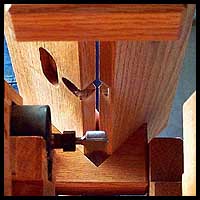

Watson Wood Working: Rapid Chamfering
Machine
By C.E. "Chuck" Ring
What started out as an offer from Mr. Tony Watson of Watson Wood Working turned into much more than an evaluation of his plans for a chamfering tool.
Originally, Mr. Watson had provided a set of plans for the tool to one of our members, however due to circumstances beyond the member's control the member could not complete the evaluation. When I notified Mr. Watson of the problem occasioned by the member's illness, he immediately offered up another set of plans for my evaluation. Shortly thereafter Mr. Watson sent the plans along with a full working model of the tool. This effort on Mr. Watson's part was beyond what he had originally agreed to and I believe his sincerity shows through with this added generosity.
The plans for the tool consists of two sheets of full-scale professionally rendered plans. Sheet #1 is a "Detail" drawing showing the dimension and configuration of all components; while sheet #2 consists of the "Assembly" details complete with notes and a detailed parts list. After careful examination of the plans, I found them to be complete in all aspects.
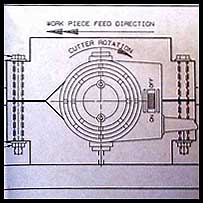 |
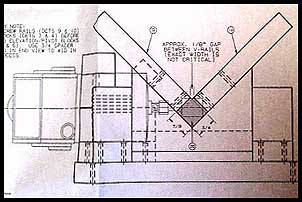 |
|
Router Mounting Details |
Showing "V"-Rail" Design |
The tool can best be described as a dedicated chamfering machine which allows one to mill chamfers of various sizes using a straight-bit and an adjusting mechanism built into the tool. The tool sent to me is powered by a Ryobi Model TR30U II Laminate Trimmer, however the plans can be adapted so that any similar power unit could be utilized.
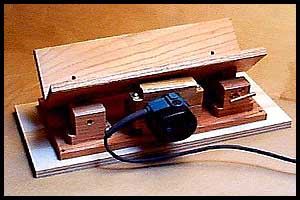 |
|
| Full Frontal View Of Tool | Underside of Jig |
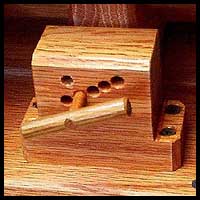 In
operation, the tool is a model of efficiency in its ease of use
and quick adjustment for the milling of different dimensioned
chamfers. The user simply chooses the size chamfer he wishes
to mill from a range of choices (1/8", 1/4", 3/8"
and 1/2"). The adjustment options are located on the face
of the machine and are locked into position by a simple wooden
dowel with a "T" handle.
In
operation, the tool is a model of efficiency in its ease of use
and quick adjustment for the milling of different dimensioned
chamfers. The user simply chooses the size chamfer he wishes
to mill from a range of choices (1/8", 1/4", 3/8"
and 1/2"). The adjustment options are located on the face
of the machine and are locked into position by a simple wooden
dowel with a "T" handle.
At Left - Height Adjustment Block With Tool Positioned For 3/8" Chamfer
Once the user has chosen the chamfer size desired and the power unit is activated, the material is fed into the bit from left to right along the bottom of the V-Rails. The chamfers which I milled using the tool were accurate and smooth along the entire length of the material.
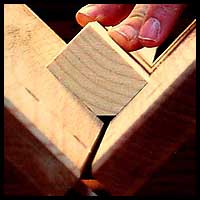 The plans contain the obligatory safety precautions
which exhort the operator to, "Always Use The Push Block
To Move The Workpiece" and "Also, Always Wear Safety
Glasses/Goggles When Working With Power Tools." Dimensions
for the push block are provided on the "Details" sheet.
The plans contain the obligatory safety precautions
which exhort the operator to, "Always Use The Push Block
To Move The Workpiece" and "Also, Always Wear Safety
Glasses/Goggles When Working With Power Tools." Dimensions
for the push block are provided on the "Details" sheet.
The plans state that the components can be made from any wood available, however the plans suggest the V-Rails be constructed of hardwood for "accuracy and durability." While the tool I tested was constructed of red oak, I believe all of the components with one or two exceptions could be constructed of a high grade of veneer plywood or MDF which might prove to be a little more stable and less costly. Whether the tool is made from hardwood or some other material, it is likely that most shops have enough scrap wood material for full construction of the tool leaving only the hardware items to be purchased.
A chamfer edge is my favorite profile and one that I use on most all my doors, gates and shutters. Although I have several router tables and a large collection of chamfer bits I believe that the Watson Woodworking Rapid Chamfering Machine will become my tool of choice for milling chamfers. Its ease of use, portability and wide range of chamfer sizes just makes it an easy choice for use. It's possible that with a little thought, planning and adaptation, this tool or a variation could be used to mill other profiles. However, I'll leave such possibilities to Mr. Watson or others with more sense and time than I have.
The plans for this tool and additional information can be found at Mr. Watson's website http://www.watsonwoodworking.com/. The price for the plans which includes shipping and handling is $22.00.
Chuck Ring
